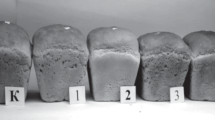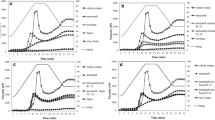Abstract
A study into the preparation and grinding of a grain mixture containing 7% flax seeds was carried out in order to obtain a composite wheat-flax flour in which the entire biopotential of flax seeds was preserved. It was revealed that the preparation of the components of the grain mixture should be carried out independently, in parallel flows. The optimal extraction conditions for the wheat-flax mixture were determined, which were the following: Extraction (%)/Ash content (%) on three break systems (in terms of I break system–grain)—53.5/1.00 for the I break system; 22.2/1.11 for the second break system; 75.7/1.035 total for I + II break systems; 81.0/1.1 total for I + II + III break systems. Technological schemes have been developed and new grades of wheat-flax flour have been created with predetermined technological properties and increased nutritional value. Peculiarities of the distribution of proteins, fats, carbohydrates and basic enzyme systems in the new grades of wheat-flax flour obtained from a binary mixture consisting of 93% wheat and 7% flax seeds were revealed. It was shown that the total fat content in flour from two-component mixtures increased by approximately four times, and the total protein content in the studied samples increased by 1–2%. An increase in the proportion of the albumin-globulin fraction in wheat-flax flour samples was noted. The activity of acid lipases is approximately 1.5 times higher than the activity of alkaline lipases in the studied samples of wheat-flax flour. The content of linoleic acid (ω-6) in the samples of wheat-flax flour is 1.6–3.3 times higher than in wheat flour; the content of linolenic acid (ω-3) in wheat-flax flour samples is 36.8–57.2 times higher than in wheat flour (taking into account the total fat content in the samples). Bread from new grades of flour received a high tasting score. The enrichment of wheat flour due to the entire phytopotential of flax seeds will make it possible to compensate for the lack of PUFA family in the diet of a modern person and to obtain products of a balanced composition.



Similar content being viewed by others
REFERENCES
Tsyganova, T.B., Minevich, I.E, Zubtsov, V.A., and Osipova, L.L., Pishchevaya tsennost’ semyan l’na i perspektivnye napravleniya ikh pererabotki (Nutritional Value of Flax Seeds and Promising Directions for Their Processing), Kaluga: Eidos, 2010.
Pankratov, G.N., Meleshkina, E.P., Vitol, I.S., Kandrokov, R.Kh., and Zhil’tsova, N.S., Features of processing products of two-component mixtures of wheat and flax, Khleboprodukty, 2018, no. 12, p. 4246. https://doi.org/10/32462-0235-2508-2018-0-12-42-46.
Koneva, S.I., Features of the use of flax seed processing products in the production of bakery products, Polzunovsk. Vestn., 2016, no. 3, pp. 35–37.
Sigareva, M.A., Mogil’nyi, M.P., and Shaltumaev, T.Sh., The use of processed products of flax seeds for the production of products of high nutritional value, Izv. Vyssh. Uchebn. Zaved., Pishch. Tekhnol., 2015, nos. 5–6, pp. 42–45.
Vitol, I.S., Pankratov, G.N., Meleshkina, E.P., and Kandrokov, R.Kh., Features of the composition and the protein-proteinase complex of flour from a two-component grain mixture and flax seeds, Tekhnol. Tovaroved. Innovatsionnykh Pishch. Prod., 2019, vol. 59, no. 6, pp. 83–85.
Vitol, I.S., Pankratov, G.N., and Meleshkina, E.P., Carbohydrate-amylase and lipid complexes of flour from a two-component grain mixture of wheat and flax, Tekhnol. Tovaroved. Innovatsionnykh Pishch. Prod., 2020, no. 1, pp. 57–61.
Zaitseva, L.V. and Nechaev, A.P., The balance of polyunsaturated fatty acids in food, Pishch. Prom-st., 2014, no. 11, pp. 56–59.
Rabetafika, H.N., Van Remoortel, V., Danthine, S., Paquot, M., and Blecker, C., Flaxseed proteins: Food uses and health benefits, Int. J. Food Sci. Technol., 2011, vol. 46, pp. 221–228. https://doi.org/10.1111/j.1365-2621.2010.02477.x
Gutte, K.B., Sahoo, A.K., and Ranveer, R.C., Bioactive components of flaxseed and its health benefits, Int. J. Pharm. Sci. Rev. Res., 2015, vol. 31, no. 1, pp. 42–51.
Bakumenko, O.E. and Shatnyuk, L.N., Technological aspects of the use of flax flour in functional food concentrates, Khleboprodukty, 2017, no. 6, pp. 56–59.
Kuhn, K.R., Netto, F.M., and Cunha, R.L.D., Assessing the potential of flaxseed protein as an emulsifier comdined with whey protein isolate, Food Res. Int., 2014, vol. 58, pp. 89–97.
Goyal, S.V., Upadhyay, N., Gill, S., and Sigag, M., Flax and flaxseed oil: An ancient medicine & modern functional food, J. Food Sci. Technol., 2014, vol. 51, no. 9, pp. 1633–1653. https://doi.org/10.1007/s13197-013-1247-9
Nechaev, A.P., Traubenberg, S.E., Kochetkova, A.A., Kolpakova, V.V., Vitol, I.S., and Kobeleva, I.B., Pishchevaya khimiya. Laboratornyi praktikum (Food Chemistry. Laboratory Workshop), St. Petersburg: GIORD, 2006.
Afanas'ev, V.A., Teoriya i praktika spetsial’noi obrabotki zernovykh komponentov v tekhnologii kombikormov: Monografiya (Theory and Practice of Special Processing of Grain Components in Feed Technology: Monograph), Voronezh: Voronezh. Gos. Univ., 2002.
Pankratov, G.N. and Rezchikov, V.A., Fiziko-khimicheskie osnovy zernovykh tekhnologii (Physicochemical Fundamentals of Grain Technologies), Moscow: IK MGUPP, 2007.
Egorov, G.A., Upravlenie tekhnologicheskimi svoistvami zerna (Management of Technological Properties of Grain), Voronezh: Voronezh. Gos. Univ., 2000.
Gridina, S.B., Zinkevich, E.P., Vladimertseva, T.A., and Zabusova, K.A., Enzymatic activity of grain crops, Vestn. Krasnodar. Gos. Agrar. Univ., 2014, no. 8, pp. 57–60.
Demchenko, Yu.A., Lipase: Properties, sources, production methods, and application, Nauka: Kompleksn. Probl., 2018, no. 2, pp. 15–34. http://www.nigniikp.adygnet.ru. Accessed December 23, 2019.
Author information
Authors and Affiliations
Corresponding author
Ethics declarations
The authors declare that they have no conflict of interest. This article does not contain any studies involving animals or human participants performed by any of the authors.
Additional information
Translated by S. Avodkova
About this article
Cite this article
Pankratov, G.N., Meleshkina, E.P., Vitol, I.S. et al. Wheat-Linen Flour: Conditions for Producing and Biochemical Features. Russ. Agricult. Sci. 46, 404–409 (2020). https://doi.org/10.3103/S1068367420040138
Received:
Revised:
Accepted:
Published:
Issue Date:
DOI: https://doi.org/10.3103/S1068367420040138




